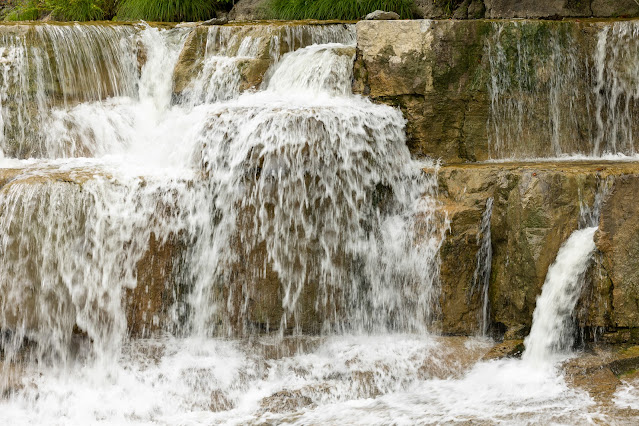In the Algonquin language, Taughannock means in the trees. The gorge is still surrounded by huge trees. It is the tallest free-falling waterfall east of the Mississippi River. Those 215 feet have been most impressive to me in deep winter when it is covered with heavy ice, and growling with a deep-throated voice. The walk up from the bottom of the falls is a popular winter outing for many.
I realized I had not explored Taughannock in summer for over ten years. So, today I took the challenge to create a fresh view of the falls in six images. I first stopped at the overlook perched high on the edge of the gorge's north wall. The September morning was foggy with a few wisps still in the tree tops.
The majority of visitors travel the 3/4 mile trail with few pauses to even look at the minor waterfall near the parking lot. I find it has a lot of attractive smaller drops across its width. Looking at right of center, I find a section with five different steps from top to bottom. In winter, much of the flow is hidden under large ice formations.
Even farther to the right edge, there is a set of three steps created by the layers of sedimentary rock.
I spent over half an hour just finding interesting patterns of falling water. So, these are my first three images, and I am still nearly 3/4 mile from the big drop. Time to work up stream.
From the first falls, the gorge closes on the creek. The fog began to disperse, revealing blue sky and painting the north wall with warm light. It's a pretty spot and easy to walk into the stream bed.
I like this view for what it tells you about the steep north wall of the gorge and the gentle steps where the stream drops a few feet to the next level. Somewhere on the vertical wall up there is a peregrine falcon nest. (I saw it this summer with great difficulty. It's very distant and the falcon's coloration blends in with the gray rocks.)
On to the falls. The first photo that I offered is all you need to understand Taughannock's height. I chose to concentrate on it's power. After a free fall of 215 feet, the water is moving so fast that it is a blur even at 1/250 second shutter speed. The spray coats the rock walls for many times the width of the cascade.
Now, I am down to image number six. Between this falls and the first one I presented, the stream works down over several layers of relatively flat stone. The surface has gentle ripples and puddles that create hundreds of small reflective "ponds". On a still day, these produce a patch work of images from the canyon walls. Seen below are islands of blue sedimentary rock in a sea of golden tree leaves on the distant slopes. I find them entertaining to explore.
These are my six from today. Allow me one more image from December, 2013 that reveals why winter is still my favorite.
And, yes, it was really cold. I am thinking maybe I can find another Seeing It in Six in October, if there are come good autumn colors.
Hope you find this enjoyable.







No comments:
Post a Comment